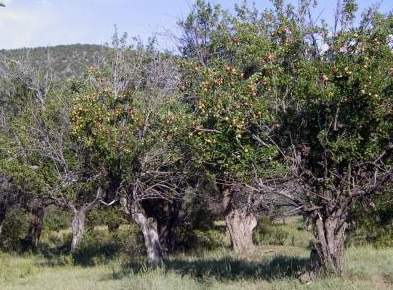
 November 5, 2009,
November 5, 2009,
Tucson,AZ – The apple trees of yesteryear are slowly disappearing. Many apple
varieties common in the U.S. a century ago can no longer be found in today’s
orchards and nurseries.
November 5, 2009,
Tucson,AZ – The apple trees of yesteryear are slowly disappearing. Many apple
varieties common in the U.S. a century ago can no longer be found in today’s
orchards and nurseries.
But some historic apple
trees still survive in abandoned farmsteads and historic orchards throughout
the U.S. Now, scientists interested in conserving these horticultural treasures
have set out to identify and catalogue them, working to discover if the last
remnants of historical trees may still be alive in American landscapes.
 |
|
| Apple trees still stand in the historic Chase Ranch orchard, planted by the Chase family circa 1870 near Cimarron, N.M. |
American horticulturalists
and historians often refer to the late 19th century as the “golden years of
apple growing,” when scores of apple and other fruit trees were planted in
farmstead and kitchen orchards. Their ability to keep all winter in cold
cellars produce flavourful ciders, and their versatility for cooking and baking
made apples a staple in American homes. This period of American horticultural
history was preceded by an era of fruit diversification that lasted into the
early nineteenth century. In 1905, the popular manual The Nomenclature of the
Apple by W.H. Ragan listed 6,654 unique apple varieties referenced in U.S.
literature between the years 1804 and 1904. A new book by Dan Bussey, The Apple
in North America (in press), lists more than 14,000 named apple cultivars
introduced to or selected in North America.
Market pressures on
commercial apple growers have reduced the diversity of apple trees once grown
in small family orchards to only a handful of commonly marketed apple
varieties. Currently, a mere 11 apple varieties account for more than 90 per
cent of the apples sold in the United States, with Red Delicious making up 41
per cent of this figure.
Have historic and heirloom
apple trees succumbed to their more popular commercially produced relatives?
Apple trees can live to remarkably old ages; single apple trees have been known
to live 150 years or longer. In many areas, it is still possible to find trees
of 'heirloom' cultivars once abundant at the beginning of the 20th century.
Remnant orchards planted before the modern era of fruit production hang on
tenaciously around abandoned farmsteads and historic orchards.
Kanin J. Routson of the
University of Arizona and colleagues at the U.S. Department of Agriculture’s
National Center for Genetic Resources Preservation published a study in the
journal HortScience that assessed the genetic diversity of 280 apple trees
growing in 43 historic farmstead and orchard sites in Arizona, Utah, and New Mexico.
The study took place from June through September 2007 and focused sampling
efforts primarily on sites dating back to the 1930s and earlier, with priority
given to trees planted before 1920.
Using seven microsatellite
markers, the researchers compared the samples to 109 cultivars likely
introduced into the southwest in the late 19th and early 20th centuries.
Genetic analysis revealed 144 genotypes represented in the 280 field samples.
According to Routson, the study identified 34 of these 144 genotypes as
cultivars brought to the region by Stark Brothers Nursery and by USDA
agricultural experiment stations. One-hundred-twenty of the total samples (43
per cent) had DNA fingerprints that suggested they were representative of these
34 cultivars.
“The remaining 160
samples, representing 110 genotypes, had unique fingerprints that did not match
any of the fingerprinted cultivars,” started the study. “The results of this
study confirm for the first time that a high diversity of historic apple
genotypes remain in homestead orchards in the U.S. southwest.”
The research team noted
that additional genetic fingerprinting of apple cultivars will enable
researchers to identify the unknown genotypes from the study.
“Until further research is
done, these unknown genotypes should be conserved and analyzed for useful
traits,” Rouston said. “Future efforts targeting orchards in the southwest
should focus on conservation for all unique genotypes as a means to sustain
both cultural heritage and biological genetic diversity.”
Print this page